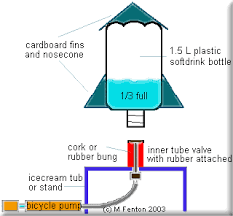Density defined in a qualitative manner as the measure of the relative "heaviness" of objects with a constant volume.
For example: A rock is obviously more dense than a crumpled piece of paper of the same size.
A styrofoam cup is less dense than a ceramic cup.
A styrofoam cup is less dense than a ceramic cup.
Density may also refer to how closely "packed" or "crowded" the material appears to be - again refer to the styrofoam vs. ceramic cup.
EXPERIMENT
- Get your hands on six cups. They don't have to be the same size, and they don't need to be clear, but it will help add to the experience.
- In each of the six cups, add one of six different amounts of salt.
▪ 0.5 tsp
▪ 1.5 tsp
▪ 2 tsp
▪ 2.5 tsp - With the salt in each cup, some warm water. Stir the solution until all of the salt has dissolved.
- Using food coloring dye the solutions in each cup a different color.
- Hold the straw near one end, wrapping your four fingers around the straw and placing your thumb over the straw's opening.
- Dip it into the first test tube, release your thumb and quickly put it on again. Repeat with the other tubes. You should end up with a rainbow effect inside the straw
- HOW DOES IT WORK?
Density is the measurement of how much "stuff" is packed into a specific space. That's how we get the equation for density. Density = Mass (stuff) ÷ Volume (space). Nearly every substance and material imaginable has a different density. This is especially the case for the solutions you make out of salt and water.
 By varying the amount of salt in the solution but keeping the water consistent at 9 oz, you create solutions that have different densities. The more salt is mixed into a water-based solution, the higher the density of that solution.
By varying the amount of salt in the solution but keeping the water consistent at 9 oz, you create solutions that have different densities. The more salt is mixed into a water-based solution, the higher the density of that solution.
FUN FACT: This dramatic salt water density change can be experienced in real life. While humans will (sort of) float in the oceans of the world, we really float in lakes like Utah's Great Salt Lake and the Dead Sea in Israel and the West Bank.
So density explains why the liquids stack atop each other inside of the straw, but how do the liquids stay in the straw? That has to be water wizardry! You expect the solutions to pour out of the straw as you remove the straw from being submerged. However, thanks to cohesion (like molecules attracting each other) and adhesion (different molecules attracting each other), there is surface tension at the bottom of the straw. The surface tension is strong enough to hold the solutions in the straw… as long as air pressure isn't added to the equation. That's why you need your thumb to cap the straw. This removes air pressure from pushing down on the solutions in the straw. Remove your thumb and the added pressure forces the solutions out.





















